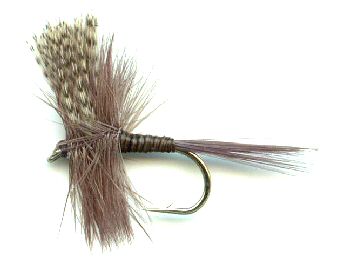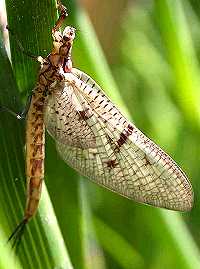The Quill Gordon Dry Fly
One of those who perhaps came to mean most for the development of American flyfishing was Theodore Gordon. He was born before the American Civil War and apparently fished the Catskill streams as early as his teens.

DRY FLY PATTERNS. Hook size 12 14 16 - $US each
Theodore Gordon corresponded with the British Fly Fishermen thought leaders Halford and Skues. Through this lofty correspondence with two of the great men of flyfishing, he acquired a fine insight into the development of English flyfishing. For the 25 years between 1890 and 1915, he was a prolific fishing writer, publishing over one hundred short articles of various kinds, mostly in British magazines like The Fishing Gazette and Forest and Stream. Gordon also published a number of articles in the Forest and Stream (USA). He was something of a loner who, in 1905, settled on the Neversink in order to be able to tie flies and do his fishing in peace and quiet.
At the end of the nineteenth century, Gordon obtained some 50 dry flies from Halford. However, these were tied according to English conditions and were therefore poor imitations of the insects which existed in Gordon's home waters. As a fly tier, though, Gordon began to tie his own dry flies with Halford's technique, but modeled on local insects. He created many original patterns, the best known being Gordon Quill, and he also developed the so-called "bumble-puppies" in the Neversink. These flies were the predecessors of the bucktail patterns, subsequently so much used.

Gordon laid the foundations for the Catskill School, which came to have a huge impact on American fly tying. The fanaticism which marked English dry-fly fishing never reached the USA and there were thus larger possibilities of experimenting. The results were significantly more sparingly dressed flies than the typical dry flies from England. These patterns, which are particularly effective on the broken eastern U.S. waters for imitating certain mayfly species, are different from the no-hackle or low riding adult mayfly imitations found elsewhere at the time. These Catskill patterns have been called the tiptoe flies, referring to the fact that when they are properly tied, only the hackles and the tail touch the water. To achieve this high riding feature, the Catskill flies are quite different from the heavily dressed flies like the Adam's or the Coachman. Others have described the Catskill patterns as having a particularly "clean" or Spartan appearance, which adds to their appeal.
With respect to imitation, the most famous Catskill fly, the Quill Gordon is first in another respect. It does a particularly effective job at imitating one of the earliest hatching large mayflies on many Pennsylvania and New York streams, starting as early as mid-April. The size of these flies and the time of their hatch apparently cause trout to feed eagerly. These mayflies (Epeorus pleuralis) are found in the faster sections of eastern rivers and thus have difficulty getting off the fast water, making them easy victims to winter-starved trout.


Fly Fishing books

